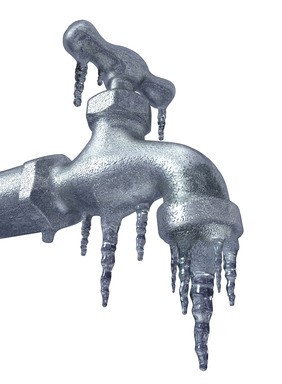Preventing Frozen Pipes For Your Home

Preventing Frozen Pipes:
Winter weather brings the threat of frozen pipes. If your power goes out due to downed power lines, there is no need to worry immediately. In most cases, a home will retain enough heat for three to five hours. It may get cold; however, as long as the temperature remains above 55ºF in your home, the pipes should not freeze.
If power is not expected to be restored within five hours, the following tips will help prevent your pipes from freezing:
- Open kitchen and bathroom cabinet doors to allow warmer air to circulate the plumbing.
- Let cold water drip from the faucet served by exposed pipes. Running water through the pipe – even at a trickle – helps prevent pipes from freezing because the temperature of the water running through it is above freezing.
If you turn on a faucet and only a trickle comes out, suspect a frozen pipe. To safely and effectively thaw frozen water pipes, you must first diagnose where the pipe is frozen.
- Start by turning on every faucet in the house, including the bathtub faucets. This will help you determine the area of the blockage. If the water in the kitchen sink is frozen but the water in the bathroom sink works, then you are probably dealing with an isolated problem. Once you have figured out which faucet contains the frozen line, turn off all other faucets.
- Locate the main water shut-off valve, which could be located in the basement. It is important to shut off the water before thawing the pipes as a pipe may already have broken under the extreme pressure caused by the frozen line.
- Now that the water is turned off, you have a few options to thaw the pipe. One is to use towels soaked in hot water. Wrap the frozen pipe with hot, wet towels and pour on additional hot water until the pipe has completely thawed. If the hot towel approach doesn't work, a hair dryer or heat gun may be the next solution. Turn on the dryer or heat gun and work up and down the length of the frozen line. Once the water starts to thaw and trickle out of the faucet, if you are sure the blockage has not caused a broken pipe, you can turn the main water supply back on. Keep working with the heat source and keep the water faucet turned on until full water pressure is restored.
If every faucet in the house is frozen, you are probably dealing with a frozen main water line that supplies water to the house. Turn on all faucets in the sinks and bathtub and turn off the main water supply. Follow the suggestions above but apply the heat directly to the pipe that enters the house. Never use a heat source with an open flame, such as a blowtorch or propane heater, to thaw a frozen water line as an open flame in a home can present a serious fire hazard as well as the possibility of exposure to carbon monoxide poisoning. Also, excessive heat from a blowtorch applied to a frozen pipe can cause the water inside the pipe to boil and possibly explode.
If your pipes have frozen once, chances are they will freeze again. Before the onset of cold weather, prevent freezing of your water supply lines and pipes by following these recommendations:
- Drain water from the swimming pool and water sprinkler supply lines following manufacturer’s or installer’s directions.
- Remove, drain, and store hoses used outdoors. Close inside valves supplying outdoor hose bibs. Open the outside hose bibs to allow water to drain. Keep the outside valve open so that any water remaining in the pipe can expand without causing the pipe to break.
- Wrap outside water pipes or water pipes located under the house or crawl spaces with an insulation material such as newspaper or electric heat tape taking special care to cover all elbow joints, valve bodies, tees, and any other fittings.
- If you are going on vacation during cold weather, leave the heat on in your home, set to a temperature no lower than 55ºF.

by
Tabitha Johnson
Client Support

